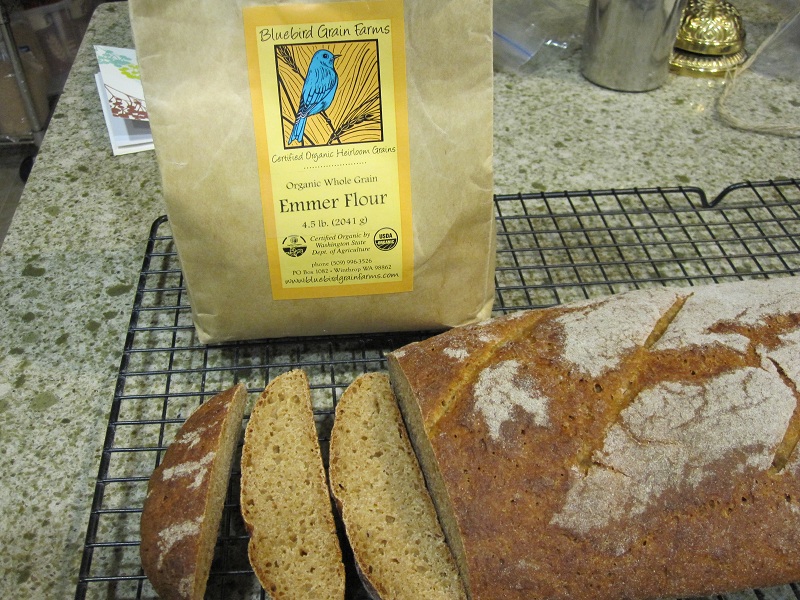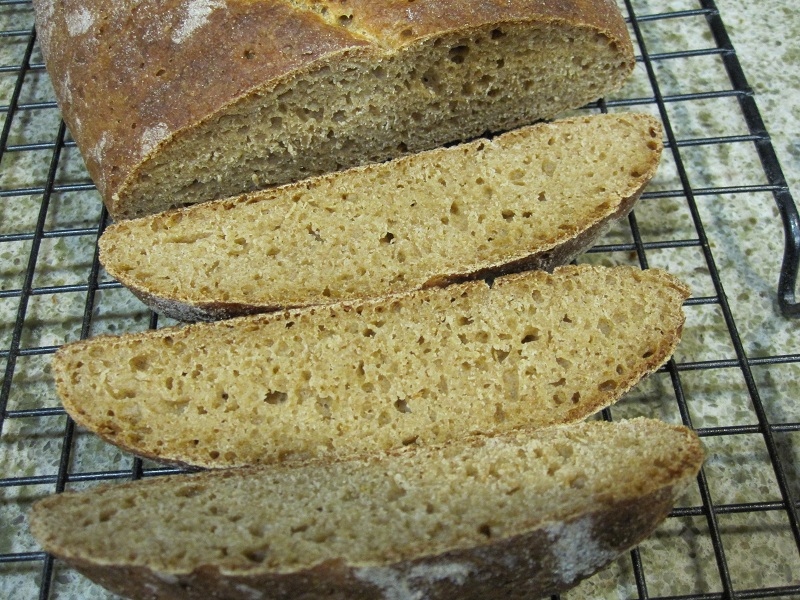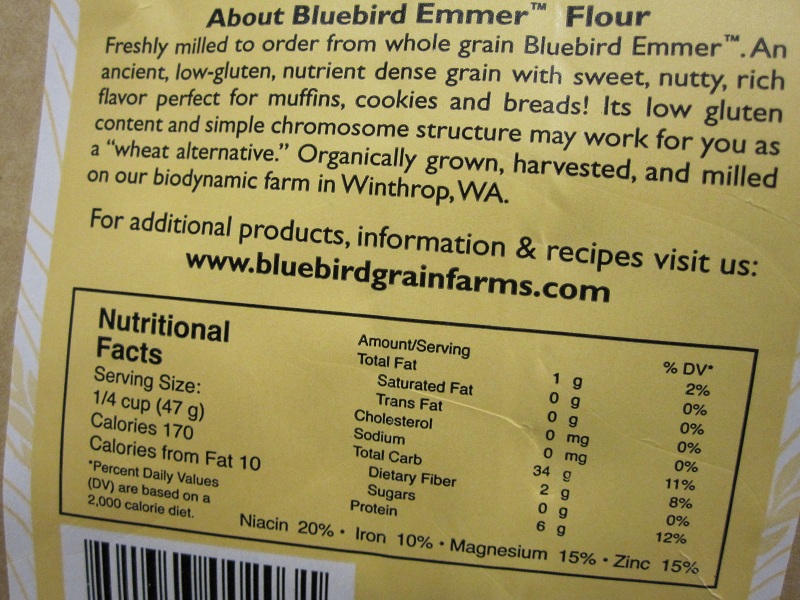I recently got some emmer (farro) flour from bluebirdgrainfarms.com ( link ) and have made 3 loaves with it so far. I got interested in emmer after researching biblical era bread making. This post includes photos of my most recent loaf and a recap of my experience so far with this flour.
For those unfamiliar with emmer, it is an "antique" grain and genetic ancester of modern wheat. I think it was used (along with barley) in Egypt and the middle east until about the time of the Roman conquest but I wasn't there so you'll have to ask the antiquarians about exact dates.
Anyway, I got curious and ordered some emmer flour from the folks at Bulubird Farms.
I've made three yeasted loaves so far with the flour: (1) an artisan loaf, 60% hydration; (2) a pan loaf, 67% hydration; and (3) another artisan loaf, 67% hydration. Each loaf was made using 450g flour, 0.5 tablespoon instant yeast, 0.5 tablespoon salt, and either 300g or 270g water.
This is a low-gluten flour that behaves differently from my usual bread flour. Emmer dough seems stickier than dough made with King Arthur flour and doesn't seem to gain "elasticity" from kneading/mixing. Labeled protein content is almost identical to King Arthur bread flour as is labeled protein content of King Arthur All Purpose flour, which I find confusing. I think 60% hydration is better than 67% to reduce stickyness. Pan loaves should only be baked in a thoroughly greased pan.
The emmer flour is a "whole grain" product that produces a crumb similar in color to regular whole wheat.
The taste of the emmer bread is quite distinctive, sort of "nutty", and I find it tasty and less harsh than whole wheat bread. The emmer flour seems a little coarse and the emmer bread feels vaguely granular in my mouth. Overall I like the bread quite a bit and it might be even better with stuff in it like sugar and raisins and such. The package label has a muffin recipe that might be very nice (if I ate muffins).
One drawback to this flour is the cost. Including shipping it's close to $4/pound!



- ph_kosel's Blog
- Log in or register to post comments
My first attempt at an emmer loaf was made with 60% hydration because I was daydreaming of perhaps making flatbread out of the dough and wanted a relatively firm dough I could form by hand. The dough, however, proved too loose and sticky for that so I bullied it into a more or less cylindrical shape and let it rise in my recently acquired linen canvas couche. It didn't rise impressively compared to loaves I've made with similar formulations using King Arthur bread flour. The resulting emmer loaf was rather small and dense and a little dry but had a nice reddish brown color and a nice, sort of nutty taste that I found more pleasant than typical whole wheat bread, somehow mellower and less harsh. The scoring went well and looked very pretty, with a nice granular appearance in the slashes. I wish I'd taken pictures, but I didn't.
The second loaf, made with 67% hydration and cooked in a bread pan (which in retrospect I did not grease well enough) also seemed reluctant to rise and had difficulty filling the pan. I had an awful time getting it out of the pan intact. It was moister than the first loaf and tasted pretty good.
The third loaf you see in the photos in my post above. It didn't get as tall as I would have wished and wasn't as pretty as my first emmer loaf, in part because some non-emmer flour from the couche discolored the crust, masking the nice reddish brown emmer color, and also because scoring on the first loaf went better.
In retrospect, none of my emmer loavess so far have risen as much as I'd like. I think this might possibly be because the emmer flour does not contain the barley malt present in most bread flours. Barley malt provides an enzyme that makes flour easier for yeast organisms to digest according to what I've read. Some barley malt or perhaps a little brown sugar might make emmer loaves rise better. I didn't add such things because I wanted to savor the emmer itself to see what it was like.
I have been curious about emmer for quite some time. Your bread looks delicious. I am thinking the advertised low gluten content is your rising problem, any grain (like oats) that suggests that it has a low enough gluten content to be an option for those that cannot tolerate gluten usually is a tough one to get to rise like regular wheat flour (my wife is gluten intolerant). The loose sticky dough you sescribe and how it behaves sounds very similar to many of the gluten free bread doughs. While my wife uses xanthan gum to compensate, if you don't have her problem you can add wheat gluten if you relly want to, but your pictures show a loaf I would be happy to bake and eat as is without adulteration. Keep posting on this please!
PS Is there a label showing the protein & ash content?
had the opportunity to work with an extremely talented baker on the subject of low gluten wheats and their use in bread.
What was suggested as a starting point:
Pre-ferment a high percentage of the flour in a firm levain (and here's the key nuance) with salt in it at a percentage equal to that in the bread.
Develop the dough well - often it may take a little more effort or a little more flour
Don't strive for high hydrations
Bulk ferment should be short ( maybe an hour total)
Shape firmly, but gently.
Bake in a receding oven, starting very hot.
Some amazing breads were made with 9% protein wheat.
I've used some of these tips to move my baking with that bad boy of grains - triticale. You might want to consider them with emmer...
Also, with my work with titicale, researcherrs found that at hydrations below 68%, the dough was very short and did not become elastic - at hydrations above this, elasticity was developed. My results seem to bear this out...
Hope this helps.
I'